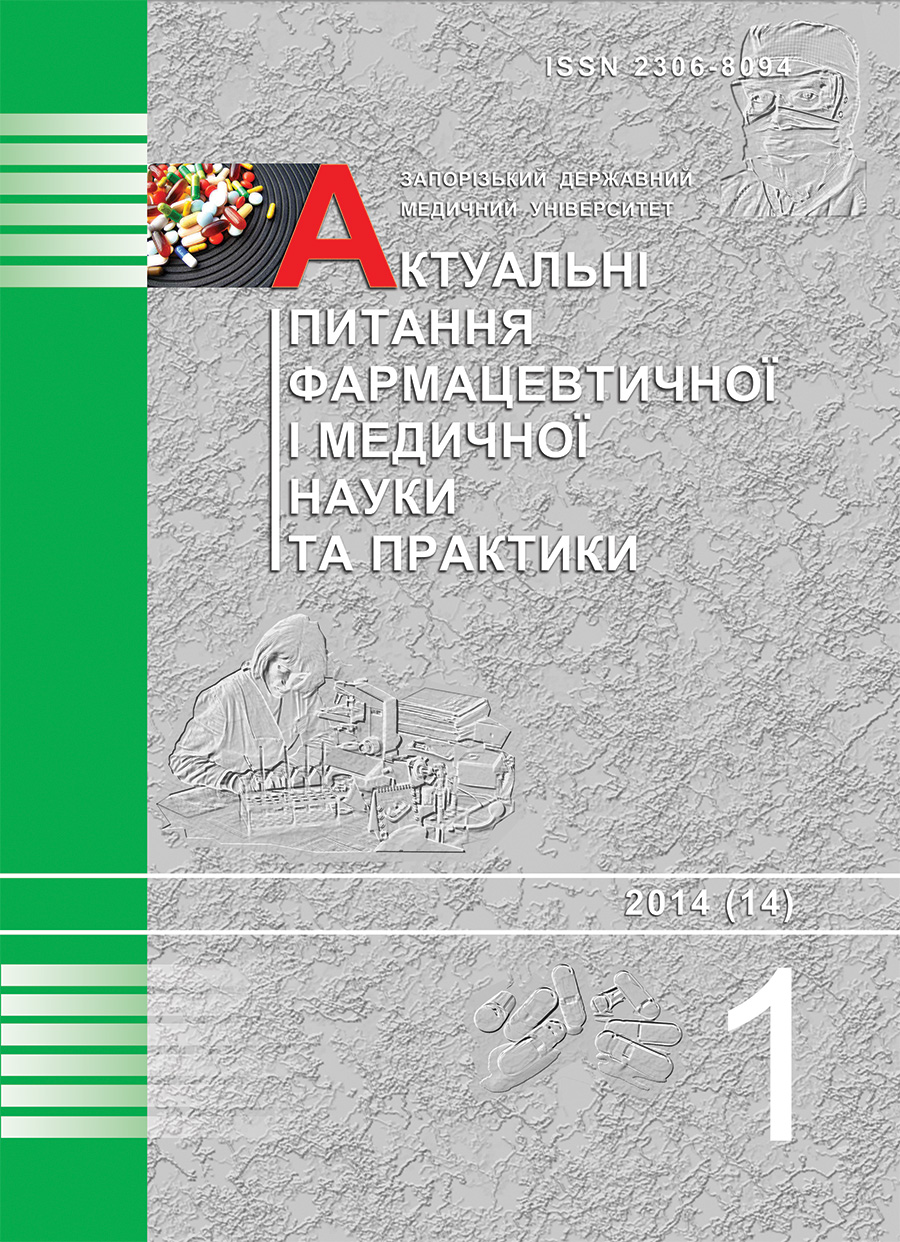PHARMACOLOGICAL STUDY OF SPECIES OF THE GENUS ACHILLEA L.
DOI:
https://doi.org/10.14739/2409-2932.2014.1.24525Keywords:
yarrow, chromato-mass spectrometry, sesquiterpenesAbstract
Introduction.
Actual problem of modern pharmacy is the expanding of officinal essential oils arsenal and the creation of new medicines on their basis. Composition and quantitative content of the components of essential oils are characterized by chemotaxonomic features and largely define the biological activity of plant materials. Representatives of genus, that are rich on sesquiterpene compounds with anti-inflammatory, anti-allergic, anti-convulsive activity deserve special attention. 25 species of the genus Achillea are known on theterritoryofUkraine. However, up to present day officinal medicine uses only Achillea millefolium L. Chemical composition of yarrow is characterized by the presence of essential oils, vitamins K, C, tannins, coumarins , flavonoids and others. Medicines of yarrow have hemostatic, hypotensive, antispasmodic, healing, choleretic action, they reinforce the secretory activity of the stomach, show choleretic effect, increase diuresis [3,5,6]. Essential oil exhibits antibacterial and antifungal activity. [7]
The purpose of the study is to conduct phytochemical research of essential oil of yarrow floodplain and to expand the resource base of medicinal plants contening azulen.
Materials and methods.
Aboveground plant parts in Zaporizhzhya region andCrimeain mass flowering have been harvested for essential oil. The essential oil has been obtained by method of hydrodistillation. Analysis of essential oils has been carried out on a chromatograph Agilent Technology – 6890 with mass spectrometric detector 5973 N. Components of essential oils have been identified by comparing the .
Investigation of wound healing activity of the essential oil of yarrow floodplain has been conducted by conventional methods [9].
Discussion of results. The essential oil content in the grass of yarrow floodplain is 0,66 ± 0,09%, in the grass yarrow is – 0,65 ± 0,02%. Essential oil obtained from the herb yarrow, is blue or light blue colored, burning taste with a characteristic peculiar smell.
35 Compounds have been identified by chromatography-mass spectrometry method in the essential oil of yarrow floodplain herb. These tables show how qualitative composition and quantitative content of all components of yarrow and yarrow floodplain essential oil differentiate. While is markedly difference in the composition of essential oil between the yarrow and yarrow floodplain, especially in content of sesquiterpenes. Thus, in the essential oil of yarrow monoterpenoids dominated, mainly due to the high content of β-pinene ( 25,35 %), sabinen ( 13,63 % ), and much less – hamazulene (11,50), germakren D (8,40), β- karyophyllene (6,06%).
In the essential oil of yarrow floodplain sesquiterpenoids are dominating, such as: hamazulen (23,23 %), karyophyllenoxydу (15,83%), β- karyophyllene (6,03 %). α- Terpineol (5,42 %), terpinen-4-ol (3,79 %), valerenal (3,58 %), borneol (3,49 %), germakren D (3,11%), piperitone (3,03 %) have been identified in smaller amounts.
Conclusion.
1. By chromatography-mass spectrometry method the essential oil of yarrow floodplain has been dominated, it contans sesquiterpenes, such as: hamazulen (23,23%), karyophyllenoxydу (15,18%), β-karyophyllene (6,03 %). Monoterpenoids: β- pinene (25,35 %), sabinene (13,63 %) have been identified in the essential oil of yarrow in large quantities.
2. As a result, pharmacological studies showed a pronounced healing effect of ointment containing essential oil of yarrow floodplain. Also a significant stimulation of hair growth on the damaged skin has been observed.
References
Державна Фармакопея України / Державне підприємство «Науково-експертний фармакопейний центр». – 1-е вид. – Доповнення 2. – Харків : Державне підприємство «Науково-експертний фармакопейний центр», 2008. –620 с.
Калинкина Т.И. Химический состав эфирных масел видов тысячелистника флоры Сибири / Т.И. Калинкина, А.Д. Дембицкий, Т.П. Березовская // Химия растительного сырья, 2000. – Т. 4. – № 3. – С. 13–16.
Кьосев П.А. Полный справочник лекарственных растений / П.А. Кьосев. – М. : Эксмопресс, 2000. – 991 с.
Ладыгина Е.А. Тысячелистник обыкновенный – Achillea millefolium L. // Фармация. – 1991. – Т 40. – № 6. – С. 90–92.
Машковский М.Д. Лекарственные средства : в 2 т. – 14-е изд., перераб. и доп. / М.Д. Машковский. – М. : Новая Волна, 2002. – Т. 1. – 543 с; Т. 2. – 590 с.
Путырский И.Н. Лекарственные растения : энциклопедия / И.Н. Путырский, В.Н. Прохоров. – 2-е изд. – Минск : Книжный Дом, 2005. – 656 с.
Селлар В. Энциклопедия эфирных масел / В. Селлар. – М. : Гранд-Фаир, 2005. – 394 с.
Солдатченко С.С. Ароматерапия / С.С. Солдатченко, Е.В. Белоусов, А.В. Пидаев. – К. : Здоров’я, 2001. – 480 с.
Стефанов О.В. Доклінічні дослідження лікарських засобів : методичні рекомендації / О.В. Стефанов. – К., 2001. – 527 с.
Shazly A.M. Comparative study of the essential oils and extracts of Achillea fragrantissim (Forssk.) Sch. Bip. and Achillea santolina L. (Asteraceae) from Egypt / A.M. Shazly, S.S. Hafez, M. Wink // Die Pharmazie. – 2004. – Vol. 59. – P. 226–230.
Downloads
How to Cite
Issue
Section
License
Authors who publish with this journal agree to the following terms:
- Authors retain copyright and grant the journal right of first publication with the work simultaneously licensed under a Creative Commons Attribution License that allows others to share the work with an acknowledgement of the work's authorship and initial publication in this journal.

- Authors are able to enter into separate, additional contractual arrangements for the non-exclusive distribution of the journal's published version of the work (e.g., post it to an institutional repository or publish it in a book), with an acknowledgement of its initial publication in this journal.
- Authors are permitted and encouraged to post their work online (e.g., in institutional repositories or on their website) prior to and during the submission process, as it can lead to productive exchanges, as well as earlier and greater citation of published work (See The Effect of Open Access)

